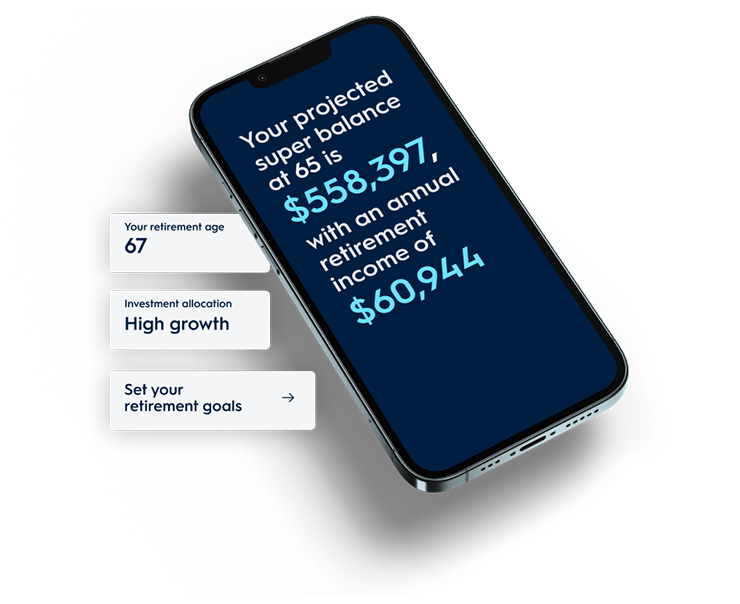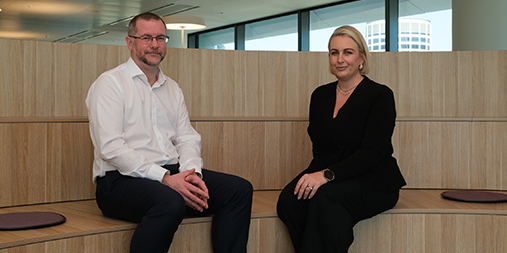
Simulate your retirement
Retirement simulator
Our retirement simulator lets you see how different choices like adding the Lifetime solution might impact how much income you have in retirement and how long your money may last.
Dreaming about retirement often conjures up images of lazy brunches, spontaneous getaways and quality time with friends and family. But beyond the daydreams, there are some important practicalities to consider – like how you’ll fund your lifestyle and what steps you need to take now to set yourself up for the future.
Whether retirement is just around the corner or still a distant goal, getting organised today can help you retire with confidence tomorrow. We’ve put together a handy checklist of key questions and considerations to help you kickstart your planning and make sure you’re ready for whatever’s next.
The retirement age in Australia isn’t set in stone. You can retire whenever you want to, but factors that could play a part might include:
your health
financial situation
employment opportunities
your (and your partner’s) individual preferences
when you can access the Age Pension
the age you can access your super.
Think about what you may like to do in retirement and what the bigger and smaller priorities may be. Consider things such as:
your social life and recreation
staying active and healthy
different retirement living options, which might include relocating to a new city
helping the kids, if you have any.
According to the Association of Superannuation Funds of Australia’s (ASFA) June 2025 figures, individuals and couples between the ages of 65 and 84 who are looking to retire today would need an annual income of around $53,289 or $75,319 respectively to fund a comfortable lifestyle.
To live a modest lifestyle, which is considered only slightly better than living on the full rate of the age pension alone, individuals and couples would need an annual budget of around $34,522 or $49,044, respectively.
For those renting on a modest lifestyle, the annual budget for individuals and couples goes up much higher, around $49,044 or $66,296, respectively.
All these ASFA figures are based on the assumption people are relatively healthy2, and are compared to the Government’s current maximum age pension rates below.3 (These rates assume the maximum pension supplement and the energy supplement).
| Comfortable lifestyle (homeowners) | Modest lifestyle (homeowners) | Modest lifestyle (renters) | Full age pension rate | |
| Single (annual budget) | $53,289 | $34,522 | $49,044 | $30,646 |
| Couple (annual budget) | $75,319 | $49,992 | $66,296 | $46,202 |
The money you use to fund your life in retirement will likely come from a range of different sources, such as:
Generally, you can start accessing super when you reach your preservation age, which will be between 55 and 60, depending on when you were born, and retire. Knowing your super balance is a crucial part of planning for retirement, as it's likely to form a substantial part of your savings.
If you’ve got more than one super account, there may also be advantages to rolling your accounts into one, such as paying one set of fees. However, there could be certain features lost in the process, such as insurance, so make sure you’re across everything before you consolidate.
You may be planning to sell or use income you’re generating from shares or an investment property, or use money you’ve saved in a savings account or term deposit to contribute to your retirement. An inheritance or proceeds from your family’s estate may also help in your later years.
Depending on your circumstances, as well as your income and assets, you may be eligible for a full or part age pension from age 65 to 67 onwards (depending on when you were born), or you mightn’t be eligible at all.
Along with your savings, government benefits, such as the Age Pension, as well as Carer’s Allowance and the Disability Support Pension, could be an important part of your retirement income.
Concession cards, which are provided if you receive certain government income support payments, or the Commonwealth Seniors Health Card could also help you access discounts on health care and other things.
Depending on how you withdraw your super and at what age, there will be different tax implications worth investigating, which will depend on your individual circumstances.
In the meantime, some of the options you’ll have around withdrawing your super include:
A transition to retirement pension enables you to access some of your super via regular payments (once you’ve reached your preservation age), whether you continue to work full-time, part-time or casually.
This may provide you with some financial flexibility in the lead up to retirement, but there will be things to consider, including that you’ll generally only be able to access a limited amount each financial year.
If you’d like to receive a regular income when you do retire from the workforce, an account-based pension (also known as an allocated pension) could be a tax-effective option, noting the value of it will be based on the super you’ve saved, so won’t guarantee an income for life.
You also won’t be limited in what you can take out, but each year you’ll need to withdraw a minimum amount. Note, you can generally only transfer up to $1.9 million in super into this type of pension too.
Another option is an annuity product, which generally provides guaranteed payments over a set number of years, or the rest of your life, depending on whether you opt for a fixed-term or lifetime annuity.
They tend to be a more secure option as they provide a guaranteed income regardless of what might happen in financial markets. However, you’ll be sacrificing some flexibility as you can’t usually make lump sum withdrawals and your life expectancy may also be a consideration.
Taking some or all of your super savings as a lump sum can be tempting, particularly if you want to pay off debt, assist the kids, or go on a holiday. However, it might not be the best option for everyone, as you’ll need to consider how you fund your lifestyle after the money is gone.
While you may be eligible for government entitlements, such as the Age Pension, it might not cover the type of lifestyle you’d like to have after you finish working.
When planning retirement, you may want to consider what outstanding debt you have and ways you may be able to reduce it while you’re still earning an income.
Check out these tips to reduce your debts before you retire and remember, if you’re experiencing financial hardship, talk to your providers, as most can assess your situation and help you find alternative payment plans.
Insurance
You might have personal insurance, possibly tied to your super fund, but it’s worth checking you have the right type and that it’s appropriate for you. After all, what you require in retirement could be quite different to when you’re working.
Investments are part of many retirement planning strategies, and when you’re retiring, it’s worth reviewing your investment style and the options you’ve chosen.
For instance, in retirement, you might consider a more conservative approach with less risk, as when you’re younger you generally have more time to ride out market highs and lows.
It’s important to think about your estate planning needs. For instance, have you documented how you want your assets to be distributed after you’re gone and how you want to be looked after if you can’t make decisions later in life?
The more you can put into super before retiring, the more money you’re likely to have when you retire.
Check out these 10 ways to boost your super, noting there are annual concessional and non-concessional super contribution caps in place and if you exceed them, additional tax and penalties may apply.
You may also be interested to know that when you reach age 55 or over, you can make a voluntary contribution to your super of up to $300,000 using the proceeds from the sale of your main residence.
For couples, both people can take advantage of this opportunity, which means up to $600,000 per couple can be contributed toward super. There are however, downsizer contribution rules you’ll want to be across.
Super rules do start to get a bit trickier as you get older and if you’re keen to know more, check out – super contribution rules when you’re in your 60s and 70s.
It starts with super…
Whatever stage of life you’re at, your super will probably become the cornerstone of your retirement strategy. If you’re an AMP member you can:
check your super balance by logging in or registering for My AMP
book a complimentary super coaching session to understand how your choices now can affect your retirement income in the future
book a Super Projection conversation with one of our specialists to discuss ways to reach your retirement goals.



AMP Super refers to SignatureSuper® which is issued by N. M. Superannuation Proprietary Limited ABN 31 008 428 322 AFSL 234654 (NM Super) and is part of the AMP Super Fund (the Fund) ABN 78 421 957 449. NM Super is the trustee of the Fund.
® SignatureSuper is a registered trademark of AMP Limited ABN 49 079 354 519.
Any advice and information is provided by AWM Services Pty Ltd ABN 15 139 353 496, AFSL 366121 (AWM Services) and is general in nature. It hasn’t taken your financial or personal circumstances into account. Taxation issues are complex. You should seek professional advice before deciding to act on any information in this article.
It’s important to consider your particular circumstances and read the relevant Product Disclosure Statement, Target Market Determination or Terms and Conditions, available from AMP at amp.com.au, or by calling 131 267, before deciding what’s right for you. The super coaching session is a super health check and is provided by AWM Services and is general advice only. It does not consider your personal circumstances. The Super Projection is a general advice conversation only, provided by AWM Services to eligible members of the AMP Super Fund.
You can read our Financial Services Guide online for information about our services, including the fees and other benefits that AMP companies and their representatives may receive in relation to products and services provided to you. You can also ask us for a hardcopy. All information on this website is subject to change without notice. AWM Services is part of the AMP group.